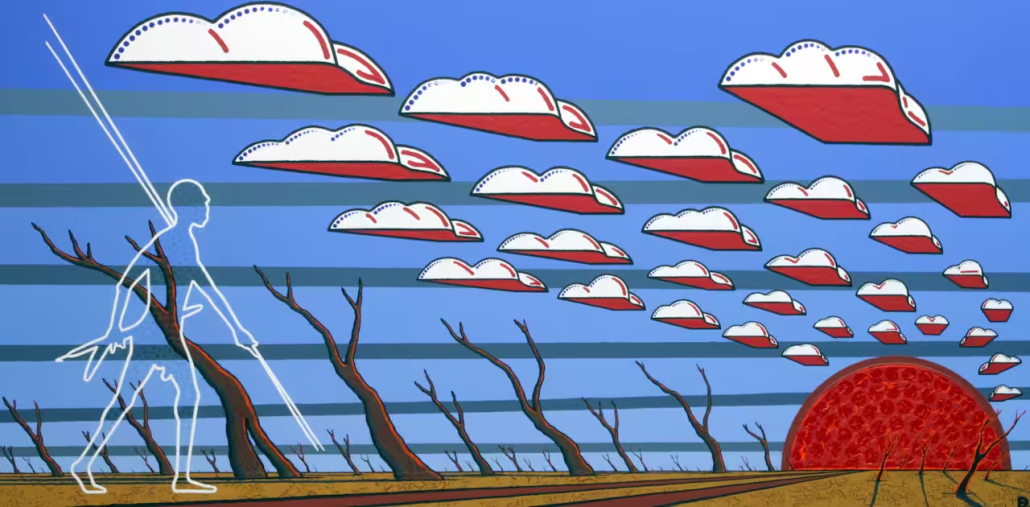Image: Chief Seattle was an ancestral leader of the Suquamish Tribe born in 1786 at the Old-Man-House village in Suquamish. His father was Schweabe, a Suquamish Chief, and his mother Scholitza was a Duwamish from a village near present Kent. Seattle was six years old when Captain George Vancouver anchored in Suquamish waters off Bainbridge Island in 1792. Photograph by E.M. Sammis, Seattle Public Library.
‘And ask the sky …’
Andrew Collis
Sky Sunday, Season of Creation B
Psalm 19; Philippians 2:3-13; Mark 15:33-39
Paul writes: “… work out your salvation with fear and trembling … It is God at work in you that creates the desire to do God’s will” (Philippians 2:12-13). The good news: cooperation with God. The good news: gift and task. The good news: grace perfecting nature (Thomas Aquinas).
There is a promise built into nature, including human nature. Salvation, wholeness and wellness, continues every day as we turn from meanness and acknowledge goodness, as we exercise moral virtues and spiritual gifts. If grace perfects nature, as C.S. Lewis writes, it must expand all our natures into the full richness of the diversity God intended … In other words, while evil shrivels into meanness, goodness expands.
I picture the wide skies – the full-colour spectrum of light and air. “The sky proclaims the glory of God, and the firmament announces the work of God’s hands” (Psalm 19:1). There is a (rainbow) promise built into nature, woven into the very fabric of nature, including human nature. Grace does not destroy but perfects nature.
This may be the most important thing to affirm during this or any Season of Creation. We are heirs to a biblical and creedal tradition that celebrates the inherent goodness – beauty and trustworthiness – of the cosmos. That means we can trust our senses, our hearts and minds, our God-given desires for intimacy and communion, justice and community.
Contrary to a popular pessimism/passivism (expressed in many Puritan hymns and spirituals), we are not completely depraved or wretched. And contrary to Gnostic escapism (expressed more broadly still), we are not destined for disembodied life. Our becoming human entails embodiment, incarnation, inter-carnation, albeit in more and more mysterious modes. The “supernatural” is not “otherworldly” as such but has to do with love – nature working with grace … grace perfecting nature.
Is there another way to say this? Perhaps. The sky – the precious atmosphere as viewed from below – is heaven. Heaven is the sky perceived with faith, hope and love.
In relation to our gospel, there are two ways we might proceed. Firstly, by way of a close reading of Mark. Secondly, by way of a song by REM.
“When noon came, darkness fell on the whole countryside and lasted until about three in the afternoon. At three, Jesus cried out in a loud voice, ‘Eloi, eloi, lama sabachthani?’ which means, ‘My God, my God, why have you forsaken me?’” (Mark 15:33-34).
The context is the passion of Jesus. As one commentator notes: “… the mockery [Jesus] undergoes is ultimately … mockery of God … There is, then, a chilling threat of divine response and judgment in the darkness that comes down upon the whole earth at the sixth hour … Almost certainly in view are words of the prophet Amos (8:9-10): ‘That day – it is the Sovereign YHWH who speaks – I will make the sun set at noon, and darken the earth in broad daylight. I will turn your feasts into funerals and all your happy songs into dirges … It will be a day of mourning, as for a dead child – all of this on that bitter day.’”
Mocking God’s Beloved, rejecting love (intimacy and communion, justice and community), is unnatural. We are thus pulled away from the world, away from ourselves …
“The pervasive darkness recalls the primeval darkness out of which the Creator summoned light and life (Genesis 1:3-5). We stand at a turning point. Is God, faced with the rejection and mockery of [the Beloved], allowing creation to go into reverse, sliding back into chaos and destruction? Or are we here at the painful birth of a new age, a new creation?” (Brendan Byrne SJ).
At the moment of Jesus’ death, we read, the temple curtain is torn apart, and this tearing corresponds to the tearing apart of the skies at the beginning of the story immediately following his baptism in the Jordan … which signals a divine response to the faithful love of Jesus – including his association with the downtrodden.
In the first instance the tearing of the skies is followed by Abba God’s assurance (1:11), an assurance of love repeated for the benefit of three privileged disciples at the transfiguration (9:7b). In the final instance of tearing (15:38), there is no accompanying divine voice acknowledging Jesus as “Beloved”. The acknowledgement (“Clearly, this was God’s Own!”) comes from the opposite direction: from the human lips of the centurion who has supervised the execution.
Love/faith/hope is making a new house of prayer for all (Jews and Gentiles, oppressed and oppressors) beneath open skies. Despite mockery and alienation – in the very midst of it – revelation …
In 1986, about the time that scientists identified holes in the ozone layer, REM recorded a song about the sky called “Fall On Me” (Berry/Buck/Mills/Stipe, 1986):
“There’s a problem, feathers, iron/ Bargain buildings, weights and pulleys/ Feathers hit the ground before the weight can leave the air/ There’s the progress, we have found/ A way to talk around the problem/ Building towered foresight/ Isn’t anything at all/ Buy the sky and sell the sky and bleed the sky and tell the sky/ Don’t fall on me (what is it up in the air for?)/ Fall on me (if it’s there for long)/ Fall on me (it’s over, it’s over me)/ Don’t fall on me// Well, I could keep it above/ But then it wouldn’t be sky anymore/ So if I send it to you, you’ve got to promise to keep it whole/ Buy the sky and sell the sky and lift your arms up to the sky/ And ask the sky and ask the sky/ Don’t fall on me …”

Image: REM, 1986 (Mojo Magazine), Getty/Paul Natkin.
I have always loved this song for holding together environmental and spiritual concerns – the “problem” of technological alienation, developer-greed, pollution, ecological collapse …
The “progress”, real or delusional – with reference to the Leaning Tower of Pisa (Galileo Galilei dropping feathers and lead weights to test the laws of gravity) and the Tower of Babel – human inquiry/ingenuity as well as human arrogance/entitlement.
The “promise” to keep it whole – not to fall for dualism, speciesism, pie-in-the-sky religion.
“Buy the sky and sell the sky” alludes to a speech given by Chief Seattle, leader of the Suquamish and Duwamish Native American tribes, in 1854. In reply to Territorial Governor Isaac Stevens and the ceding of the Washington State territories, Chief Seattle laments/asks: “How can you buy or sell the sky, the warmth of the land?”
This “asking” is crucial. At the beginning of the song, it’s “tell the sky”, as if the singer could tell nature what to do. By the end, it’s “ask the sky”… it’s “lift your arms up to the sky” – a more respectful, even worshipful disposition.
I recall, then, Blak Douglas’ depiction of black-mist poisoning (clouds of radioactive fallout) at Maralinga on Anangu country. The burnt barren trees are bent, leaning to one side with their branches split in two representing the letter Y. The artist laments: “I’m asking why did this happen to us people.”

Image: The burnt, barren trees in Blak Douglas’s ‘Tjarutja Tragedy’ (2016) are bent, leaning to one side with their branches split in two representing the letter Y. “That’s because I’m asking why did this happen to us people?” The Dunghutti artist’s work captures a land destroyed by atomic testing and speaks to the deep displacement of its Traditional Owners. “I wanted to create a piece that really encapsulated the return of blackfellas to their country when your country has been blasted. It’s metaphoric for a lot of blackfellas …” he told NITV News. On September 27, 1956, the British government exploded an atomic bomb on the traditional lands of the Anangu in remote western South Australia. The fission bomb created a huge mushroom cloud over more than 3,000 square kilometres of the now dusty site, known as Maralinga. It was just one of 12 tests carried out across the country throughout the 1950s.
We can/must ask questions, difficult questions … in the process of working out our salvation – singing, trembling, thinking, resisting, witnessing, confessing, lamenting, celebrating …
Does not Jesus himself ask, the darkness falling, “My God, my God, why have you forsaken me?” And beneath open skies, may we ourselves not confess – before getting (back) to work – “Clearly, this was God’s Own!” Amen.




